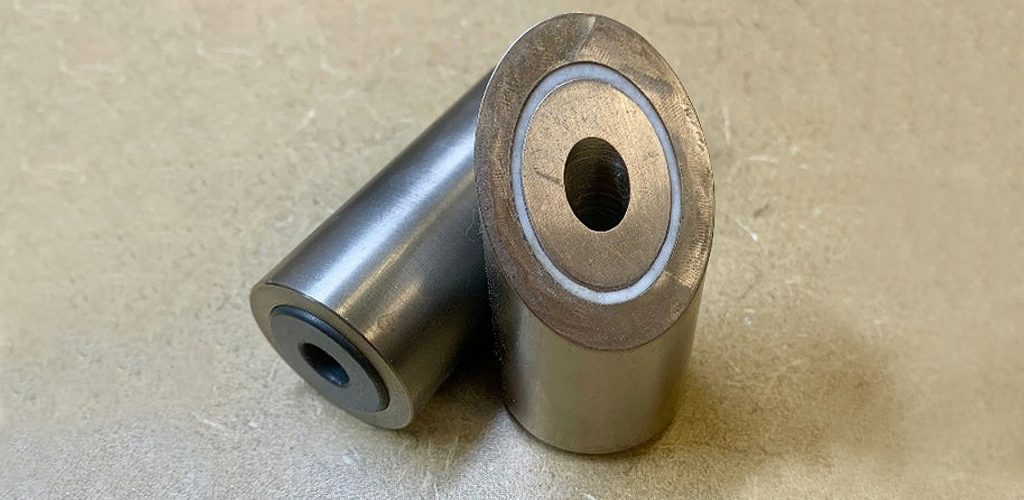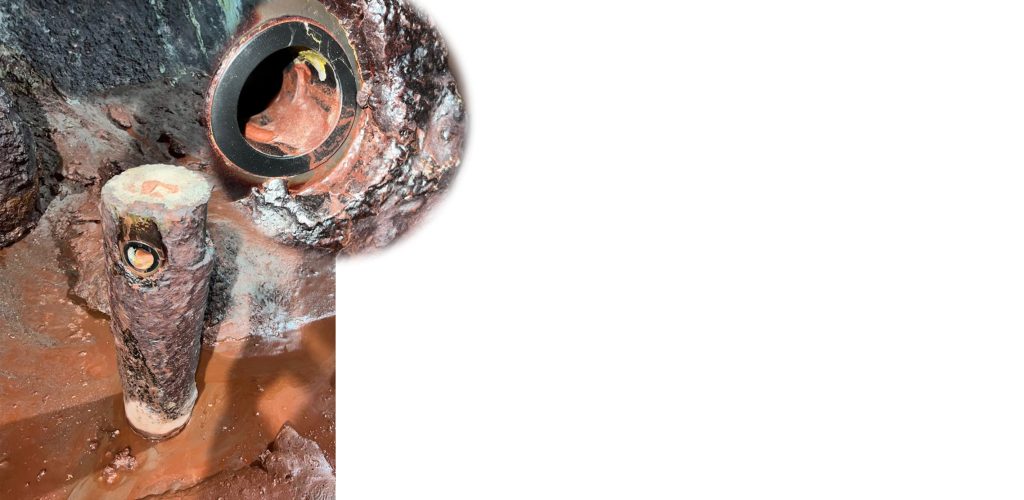Caldera Products
Caldera Products
Oxygen Sparges

Bimatalic Sparger cross-section
Oxygen sparger systems are essential for efficient oxygen distribution in Pressure Oxidation (POX) autoclaves, but their design and durability remain a significant operational challenge. Due to the high risk of reactive metal fires, titanium cannot be used, which is the standard material of construction inside the corrosive environment of the autoclaves. Most sites use super duplex stainless. However, they corrode in the harsh environment, resulting in spargers being considered consumable components, requiring frequent replacement.
In addition to corrosion, several operational issues frequently arise:
- External erosion: High-velocity eddy currents formed during oxygen injection cause wear on sparger tips.
- Scaling and blockages: Slurry backflow results in restrictive scale build-up, which can harden significantly if the autoclave remains at temperature and in operation.
- Particulate ingress: Large grit or scaling fragments may enter sparger outlet port, reducing oxygen flow and causing plugging.
- Gas Embrittlement: Super duplex stainless steels often do not last long enough to identify this issue, but when other, highly corrosive resistant, non-reactive metals like tantalum are used, these can suffer from oxygen-induced embrittlement, which significantly reduces the metal’s ductility, making it more prone to cracking.
- Internal abrasion: During periods of low oxygen flow, backflow of slurry or abrasive solids can wear sparger interiors, reducing their lifespan.
Based on conservative engineering interpretations of fire safety standards, oxygen linear velocity in sparger systems is typically limited to 9–12 m/s. This constraint often results in average velocities around 5 m/s during normal operation and as low as 2 m/s during periods of reduced oxygen addition. These low velocities increase the risk of slurry ingress, which can lead to internal sparger wear and plugging.
Caldera has a proud history of collaborating with clients to develop custom solutions for demanding applications. More than 15 years ago, Caldera was tasked with designing a safe, long-life oxygen sparger system suitable for the harsh POX environment. This collaboration led to the development of Caldera’s bimetallic and ceramic-lined sparger systems, which have since been successfully deployed in both top and bottom injection configurations.
The bimetallic spargers feature an inner sleeve made from duplex stainless steel or a high-nickel alloy, encased within a corrosion-resistant titanium outer tube. A PTFE insulation layer separates the two metals. This configuration ensures a highly corrosion-resistant exterior while maintaining a fire-resistant, oxygen-compatible internal material. A ceramic tip isolates the oxygen stream at the injection point, preventing contact with the titanium.
In contrast to metals, fired ceramics are classified as non-flammable according to ASTM G63. This allows Caldera’s ceramic-lined spargers to operate at higher linear velocities (>15 m/s), significantly reducing the likelihood of slurry ingress, even during low oxygen flow conditions. Furthermore, the non-wetting characteristics of the ceramic lining minimize internal scaling during system shutdowns or oxygen outages.

Used Oxygen Sparger pipe
These spargers also incorporate reduced-bore ports designed to have the highest oxygen velocity throughout the system. These high velocity ports act as the primary barrier against backflow. The tortuous path geometry prevents the entry of large particulate scale when the system is offline. The titanium outer layer is fully isolated from pure oxygen by ceramic tubes, mortar, and PTFE liners. There has never been a recorded metallic fire involving Caldera’s titanium spargers
While the higher velocities introduce an increased pressure drop, these values are typically modest. In most installations, the oxygen supply flow control valve and control software can easily compensate for this pressure requirement.
